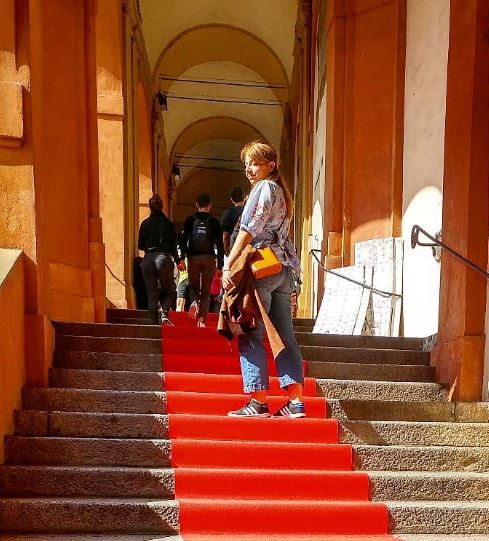Among the Ancient Trees
Updated on 21 June 2022 From Karoline Villacidro
Wandering through ancient villages and expanses of chestnut groves, in those places you visit for the first time or where you are used to walking, you look up and catch a glimpse of the ancient trees. Guess their age until you lose count.
In the
enchanting and perfectly preserved Borgo La Scola a Grizzana Morandi, pearl of
the Bologna Apennines, between the high peaks of the towers and the historic
buildings, stands the majestic cypress that, with its 25 m height and an
estimated age of over 700 years, is a real natural monument, perfectly inserted
in the harmony of the mountain landscape. The cypress is, in fact, a very
longlived tree that can exceed 500 years of age, as in this case, and is a
symbol of immortality and wisdom in the local culture.

The chestnut tree represents the intimate and deep relationship that binds it to
mankind. Therefore, the Fondazione Cassa di Risparmio together with the Accademia
dell'Agricoltura have created a 10-hectare experimental and educational park to
rediscover chestnut growing and to keep its tradition alive. Through the
creation of an efficient centre for the protection of biodiversity, this park
is committed to the promotion of a cultural and scientific itinerary for the
enhancement of agricultural and food resources and illustrates the history of
the chestnut tree and the various forms of recovery.
The centuries-old
"woods grandfathers" at the Poranceto Woods have a circumference of up to 10 metres. It tells of
a distant and magical past, for those who have time to stop and listen. And
right here comes the Museum, housed in the restored spaces of old rural buildings
(such as the cattleshed and the hayloft), where you learn about the differences
between the types of forests of the area and their connection to human history.

In the area
in front of Villa Smeraldi in Bentivoglio, which houses the Museo della Civiltà Contadina,
there are numerous examples of horse chestnut, near the ice-house and the
dovecote, while in the larger area behind the historic house, the vegetation is
varied: from the most typical plants to those who follow the rules of design of
the "romantic" garden, coming from different vegetation realities. On
the other hand, there are powerful trees with bright colours such as elms, holm
oaks and laburnum, but none of them compete with the majestic example of bald cypress
that stands on the shores of the lake.
This
ancient tree certainly does not go unnoticed, for its foliage of a thousand
colors and for its mighty pride, well rooted not far from the City Opera House of Bologna. The Ginkgo Biloba, also known as the "Tree of the 40
Shields", has rather curious leaves, small, unusually fanshaped and split,
and 150 million years ago, in the lands now called Asia, Europe and North America,
it extended into huge forests inhabited by dinosaurs and all prehistoric
animals. This true specimen of a living fossil is undoubtedly worth a visit.

The
Municipal Library is in the ancient fourteenth-century convent of St. Francis
with a patrimony of about 450.000 volumes, rare books and unique documents. The
rooms are beautifully frescoed and every corner oozes with history and beauty,
not just inside. In the courtyard of the Library stands the ancient cedar,
guardian of secrets and tales in the shade of its thick foliage.
Piazza
Malpighi is a space without greenery, at the center of which stands the column
of the Virgin Mary, with a copper statue of the Madonna designed by Guido Reni.
However, in a small courtyard overlooking the square, there is a monumental
plane tree that can be seen from afar and is the most imposing tree in the old
town of Bologna. The green area is divided into two flowerbeds by a low wall
and the first flowerbed is completely occupied by the underside of the plane
tree.

It is
probably the oldest church in Imola, dating back to the seventh century and
stands on the ruins of another building of worship, a Benedictine monastery. Inside,
it houses a large porticoed cloister whose protagonist is a very ancient and
rare example of centuries-old vine that is presumed to be more than 200 years
old. Its shoots cover the entire area, giving the sacred site an even more
exciting and suggestive appearance.
It soon
became one of the most important mental hospitals in Italy, covering an area of
about 140.000 square meters. Inside this historic complex in Imola are the Convent
of the Osservanza and the Church of San Michele with two harmonious and elegant
cloisters. In recent years, it has been the subject of an urban redevelopment
project to enhance the green area with monumental centuries-old trees and 500
tree varieties. A unique complex, easily accessible to all, on foot or by bike,
and equipped with new lighting and video surveillance systems for the safety of
all visitors.

Ph. imolafaenza.it
During an
exploration of the hills around Pianoro (BO), Luigi Fantini, a famous
archaeologist and speleologist, discovered a rare example of vine, survived the
devastating epidemic of phylloxera that caused most of the European vineyards
to disappear at the end of the 1800s. The plant, with a trunk of about 120 cm
in circumference and shoots of over 10 meters, is coupled with an ancient elm.
In 2002, Stefano Galli found the vine in a state of abandonment and did his
best for its survival. After extensive research, they established that the
centuries-old "Fantini vine" does not belong to any of the vines listed
in the National Register of Vine Varieties, but that it is a particular
autonomous variety.
Source: Comune di Bologna

